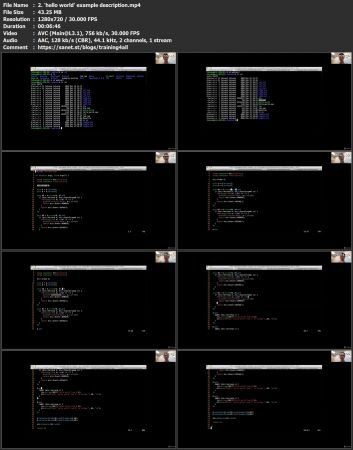[ FreeCourseWeb.com ] VSD - Distributed timing analysis within 100 lines code
Download More Latest Courses Visit -->> https://FreeCourseWeb.com

Video: .MP4, 1280x720 30 fps | Audio: AAC, 44.1 kHz, 2ch | Duration: 01:45:40
Genre: eLearning | Language: English + Subtitles | Size: 623 MB
Distribute, divide and rule
What you'll learn
Learn, code, analyze distributed framework
Take up and run STA for challenging designs with hugh instance count and witness the benefits of distributed STA
Requirements
Be able to install and run Opentimer, which is opensource STA tool
Be able to understand Unix commands
Be able to understand basic STA terms and terminologies which can be learnt on Udemy, from Static timing analysis - Part 1 and 2 course
Description
This webinar was conducted on 26th May 2018.
1) What happens when you type set_multi_cpu_usage -localCpu 4 on your EDA timing shell?2) What happens when you type set_multi_cpu_usage -localCpu 4 -numThreads 4 on your EDA timing shell? I had a curiosity, while working at my previous design companies, about how jobs are getting spawned on different machines? What if there are less machines and more jobs, and vice versa? How does the algorithm of a timing engine handles this? I myself used to setup the entire distributed MMMC framework for timing tools at customer place, which was just setting the right variables (set_multi_cpu_usage), but never knew what goes behind the tools. Its the curiosity which leads to queries which leads to exploration and finally, leads to answers. I found my answers from Tsung-Wei, who is the architect of popular opensource STA Tool Opentimer. We all know timing analysis is a really important task in overall chip design flow and its so complex and difficult task. The chip that we incorporate today has billions of transistors, resulting timing analysis runtime is tool large. Also, we need to analyze timing under different conditions, so its not just a single run that you get a final result. While there are several solutions to mitigate this computation issue, the problem is most of the work is architecturally constrained by single machine. And as design complexity continue to grow larger and larger, we have to add more and more CPU and memories to the machine, but not very cost-efficient There are multiple places, we can introduce distributed computing to timing and major motivation is to speed up the timing closure. We have to analyze timing under different range of conditions, typically quantified as modes (test mode, functional mode) and corner (PVT). The number of combinations (timing views) you have to run is typically increasing exponentially with lower nodes. That's where you need to need to distribute timing analyses across different machines.So let's distribute it and do it within 100lines of code using DTCraft - A High-performance cluster computing engine. Welcome to the webinar on "Distributed timing analysis within 100 lines of code"
Do you want to find your answers too? Enroll in the upcoming webinar on "Distributed timing analysis" with Tsung-Wei, do labs on your own, understand the framework and I can guarantee you would be a better STA engineer or Lead than you were before
Speaker Profile:Tsung-Wei Huang
Tsung-Wei Huang is Research Assistant Professor, in Department of Electrical and Computer Engineering at University of Illinois at Urbana-Champaign, IL, USA. He has done his PhD in Electrical and Computer Engineering at UIUC. He holds 2 patents and more than 30 Conference and Journal Paper publications
Who this course is for:
This course is for people who are proficient with timing concepts and want to move a level ahead, and stay ahead of curve
Anyone enthusiastic to learn about distributed timing analysis from scratch i.e. from C++ code level
Use Winrar to Extract. And use a shorter path when extracting, such as C: drive
ALSO ANOTHER TIP: You Can Easily Navigate Using Winrar and Rename the Too Long File/ Folder Name if Needed While You Cannot in Default Windows Explorer. You are Welcome ! :)
Download More Latest Courses Visit -->> https://FreeCourseWeb.com
Get Latest Apps Tips and Tricks -->> https://AppWikia.com
We upload these learning materials for the people from all over the world, who have the talent and motivation to sharpen their skills/ knowledge but do not have the financial support to afford the materials. If you like this content and if you are truly in a position that you can actually buy the materials, then Please, we repeat, Please, Support Authors. They Deserve it! Because always remember, without "Them", you and we won't be here having this conversation. Think about it! Peace...




